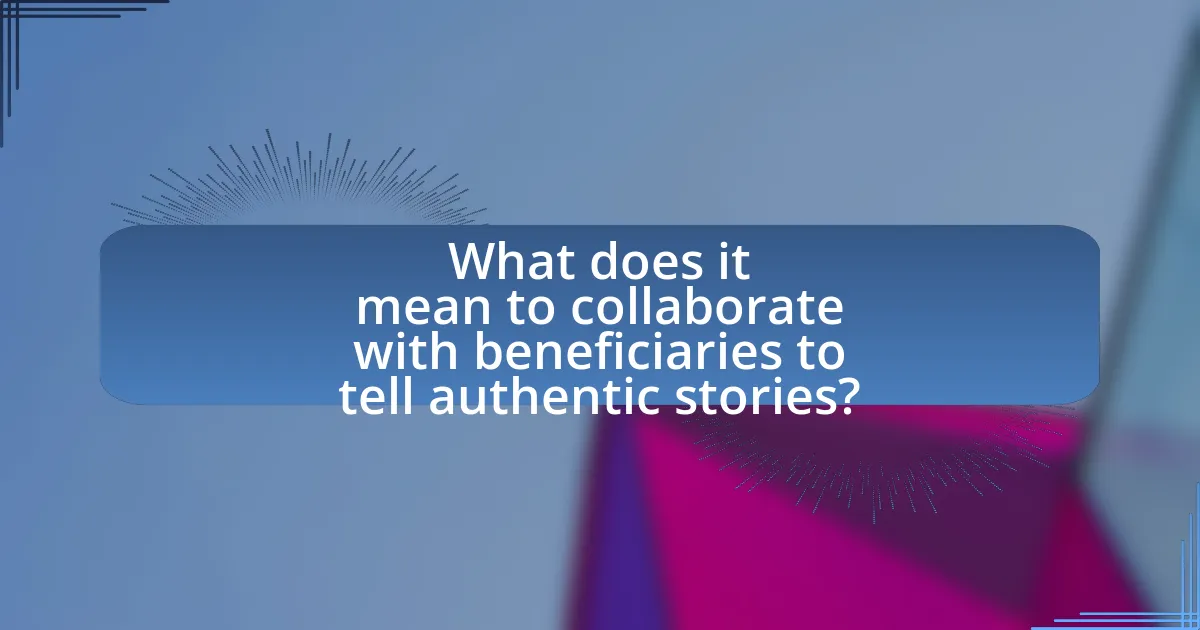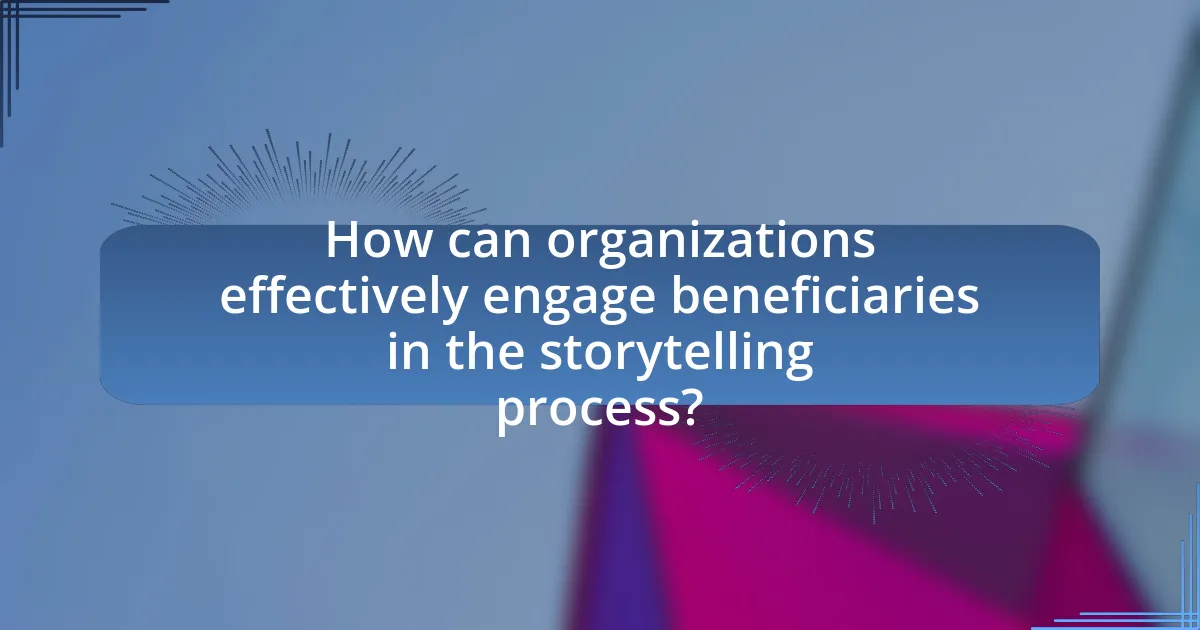Collaborating with beneficiaries to tell authentic stories involves engaging individuals directly impacted by programs to share their experiences, ensuring narratives reflect genuine realities. This collaboration enhances the credibility and relatability of stories, fostering empathy and understanding among audiences. Key principles for effective collaboration include mutual respect, active participation, transparency, and shared decision-making, which help build trust and empower beneficiaries. The article explores methods for involving beneficiaries in storytelling, the emotional benefits they experience, and the broader implications for organizations, emphasizing the importance of ethical practices and effective communication in creating impactful narratives.

What does it mean to collaborate with beneficiaries to tell authentic stories?
Collaborating with beneficiaries to tell authentic stories means engaging individuals who are directly impacted by a program or initiative to share their experiences and perspectives. This collaboration ensures that the narratives presented are genuine and reflect the true impact of the work being done. By involving beneficiaries, organizations can capture diverse viewpoints and lived experiences, which enhances the credibility and relatability of the stories. Research indicates that storytelling involving beneficiaries can lead to increased empathy and understanding among audiences, thereby fostering stronger connections and support for the cause.
Why is collaboration with beneficiaries important in storytelling?
Collaboration with beneficiaries is important in storytelling because it ensures that narratives are authentic and accurately reflect the experiences and perspectives of those directly affected. Engaging beneficiaries in the storytelling process allows for a deeper understanding of their needs, challenges, and successes, which enhances the credibility and relatability of the story. Research indicates that stories co-created with beneficiaries resonate more with audiences, leading to increased empathy and support for the cause. For instance, a study by the Stanford Social Innovation Review found that stories told from the beneficiaries’ viewpoints significantly improved audience engagement and understanding of social issues.
What unique perspectives do beneficiaries bring to storytelling?
Beneficiaries bring firsthand experiences and insights that enrich storytelling by providing authentic narratives. Their unique perspectives stem from living through the challenges and successes that the stories aim to convey, allowing for a deeper emotional connection with the audience. For instance, beneficiaries can highlight specific cultural contexts, personal struggles, and triumphs that may not be visible to external observers, thus ensuring that the stories reflect genuine realities. This authenticity is crucial, as it fosters trust and relatability, making the narratives more impactful and engaging for the audience.
How does collaboration enhance the authenticity of the stories told?
Collaboration enhances the authenticity of stories told by integrating diverse perspectives and experiences from multiple contributors. When individuals from different backgrounds come together, they bring unique insights that enrich the narrative, making it more relatable and genuine. Research indicates that stories co-created with beneficiaries reflect their lived experiences more accurately, fostering a deeper connection with the audience. For instance, a study by the Stanford Social Innovation Review highlights that narratives developed through collaboration with community members lead to more credible and impactful storytelling, as they capture the true essence of the beneficiaries’ experiences.
What are the key principles of effective collaboration with beneficiaries?
The key principles of effective collaboration with beneficiaries include mutual respect, active participation, transparency, and shared decision-making. Mutual respect ensures that beneficiaries feel valued and their perspectives are acknowledged, fostering a trusting relationship. Active participation involves engaging beneficiaries in the planning and implementation processes, which enhances ownership and relevance of the initiatives. Transparency in communication builds trust and ensures that beneficiaries are informed about goals, processes, and outcomes. Shared decision-making empowers beneficiaries by involving them in critical choices, leading to more effective and sustainable solutions. These principles are supported by research indicating that collaborative approaches significantly improve project outcomes and beneficiary satisfaction.
How can trust be built between storytellers and beneficiaries?
Trust can be built between storytellers and beneficiaries through transparent communication and mutual respect. When storytellers engage beneficiaries in the storytelling process, they create a collaborative environment that values the beneficiaries’ perspectives and experiences. This approach fosters a sense of ownership and authenticity, as beneficiaries feel their voices are heard and represented accurately. Research indicates that participatory storytelling, where beneficiaries contribute to the narrative, enhances trust and strengthens relationships, as seen in initiatives like the “Voices of Youth” project by UNICEF, which emphasizes the importance of youth involvement in sharing their stories.
What role does consent play in the storytelling process?
Consent is fundamental in the storytelling process as it ensures that individuals have the right to control how their stories are shared and represented. This respect for autonomy fosters trust between storytellers and subjects, which is crucial for authentic narratives. For instance, obtaining consent allows storytellers to ethically engage with beneficiaries, ensuring that their perspectives are accurately portrayed and that they are comfortable with the dissemination of their stories. Research indicates that ethical storytelling practices, which include obtaining informed consent, lead to more meaningful and respectful collaborations, enhancing the overall impact of the narrative.

How can organizations effectively engage beneficiaries in the storytelling process?
Organizations can effectively engage beneficiaries in the storytelling process by actively involving them in the narrative development, ensuring their voices and experiences are authentically represented. This can be achieved through methods such as conducting interviews, facilitating workshops, and providing platforms for beneficiaries to share their stories directly. Research indicates that when beneficiaries participate in storytelling, it enhances the authenticity and relatability of the narratives, leading to greater emotional impact and connection with the audience. For instance, a study by the Stanford Social Innovation Review highlights that organizations that incorporate beneficiary perspectives in their storytelling see increased engagement and support from stakeholders.
What methods can be used to involve beneficiaries in storytelling?
To involve beneficiaries in storytelling, methods such as participatory workshops, interviews, and co-creation sessions can be utilized. Participatory workshops allow beneficiaries to share their experiences and insights in a structured environment, fostering collaboration. Interviews provide a platform for beneficiaries to narrate their stories in their own words, ensuring authenticity. Co-creation sessions engage beneficiaries in the storytelling process, allowing them to contribute to the narrative development actively. These methods have been shown to enhance the richness and authenticity of stories, as evidenced by case studies in community development projects where beneficiary involvement led to more relatable and impactful narratives.
How can interviews be structured to elicit authentic narratives?
Interviews can be structured to elicit authentic narratives by employing open-ended questions that encourage detailed responses and personal reflections. This approach allows interviewees to share their experiences in their own words, fostering a deeper connection to their stories. Research indicates that using techniques such as active listening, follow-up questions, and creating a comfortable environment enhances the authenticity of the narratives shared. For instance, a study by McCracken (1988) highlights that open-ended questions lead to richer, more nuanced responses, as they allow individuals to explore their thoughts and feelings without constraints.
What tools can facilitate collaboration between storytellers and beneficiaries?
Digital platforms such as collaborative storytelling software, project management tools, and social media can facilitate collaboration between storytellers and beneficiaries. Collaborative storytelling software like StoryMapJS allows users to create interactive narratives that incorporate input from beneficiaries, ensuring their voices are represented. Project management tools such as Trello or Asana enable storytellers and beneficiaries to organize tasks, share updates, and track progress collaboratively. Social media platforms provide a space for real-time communication and feedback, fostering a dialogue that enhances the storytelling process. These tools collectively enhance engagement, transparency, and authenticity in storytelling.
What challenges might arise when collaborating with beneficiaries?
Challenges that might arise when collaborating with beneficiaries include communication barriers, differing expectations, and power imbalances. Communication barriers can stem from language differences or varying levels of literacy, which can hinder effective dialogue and understanding. Differing expectations may occur when beneficiaries have different goals or outcomes in mind compared to the collaborating organization, leading to potential conflicts or dissatisfaction. Power imbalances can manifest when beneficiaries feel marginalized or lack agency in the collaboration process, which can affect their willingness to participate and share their stories authentically. These challenges are documented in various studies, such as the research by Cornwall and Jewkes (1995), which highlights the importance of addressing power dynamics in participatory approaches.
How can cultural sensitivities impact the storytelling process?
Cultural sensitivities significantly impact the storytelling process by shaping the narratives that resonate with diverse audiences. When storytellers acknowledge and respect cultural differences, they create authentic and relatable content that reflects the values, beliefs, and experiences of the communities involved. For instance, research by the Pew Research Center indicates that culturally sensitive storytelling can enhance audience engagement and foster empathy, as it allows individuals to see their own experiences represented in the narrative. This approach not only promotes inclusivity but also mitigates the risk of cultural appropriation or misrepresentation, which can alienate audiences and undermine the integrity of the story being told.
What strategies can be employed to overcome communication barriers?
To overcome communication barriers, employing strategies such as active listening, simplifying language, and utilizing visual aids is essential. Active listening ensures that all parties feel heard and understood, which fosters a more open dialogue. Simplifying language reduces misunderstandings, making it easier for individuals from diverse backgrounds to engage effectively. Utilizing visual aids, such as charts or images, can bridge gaps in comprehension, particularly in cross-cultural contexts. Research indicates that these strategies enhance clarity and facilitate better collaboration, as evidenced by studies showing improved outcomes in communication when these methods are applied in diverse settings.

What are the outcomes of telling authentic stories through beneficiary collaboration?
Telling authentic stories through beneficiary collaboration leads to increased engagement and trust among stakeholders. When beneficiaries actively participate in storytelling, their unique perspectives enhance the narrative’s authenticity, fostering a deeper emotional connection with the audience. Research indicates that organizations that incorporate beneficiary voices in their communications experience a 30% increase in donor retention rates, as seen in studies conducted by the Nonprofit Research Collaborative. This collaborative approach not only amplifies the impact of the stories shared but also empowers beneficiaries, giving them a platform to influence and shape the narrative surrounding their experiences.
How does storytelling impact the beneficiaries themselves?
Storytelling significantly impacts beneficiaries by empowering them to share their experiences and perspectives, fostering a sense of agency and connection. When beneficiaries engage in storytelling, they often experience increased self-esteem and validation, as their narratives are recognized and valued by others. Research indicates that storytelling can enhance emotional well-being; for instance, a study published in the Journal of Health Psychology found that individuals who narrate their personal stories report improved mental health outcomes and greater resilience. This process not only allows beneficiaries to articulate their challenges and triumphs but also cultivates empathy and understanding among audiences, ultimately leading to greater support for their causes.
What emotional benefits do beneficiaries experience from sharing their stories?
Beneficiaries experience several emotional benefits from sharing their stories, including increased self-esteem, a sense of empowerment, and emotional relief. When beneficiaries articulate their experiences, they often feel validated and recognized, which enhances their self-worth. This process can empower them by allowing them to take control of their narrative, fostering a sense of agency. Additionally, sharing stories can provide emotional relief, as it allows individuals to process their experiences and connect with others, reducing feelings of isolation. Research indicates that storytelling can lead to improved mental health outcomes, as it encourages reflection and emotional expression, further supporting these emotional benefits.
How can storytelling empower beneficiaries in their communities?
Storytelling can empower beneficiaries in their communities by giving them a platform to share their experiences and perspectives, fostering a sense of agency and belonging. When beneficiaries narrate their own stories, they can highlight their challenges and successes, which can lead to increased visibility and understanding within the community. Research shows that storytelling can enhance social cohesion and mobilize community action, as seen in initiatives like the “StoryCorps” project, which has documented over 600,000 personal stories, promoting empathy and connection among diverse groups. This process not only validates the beneficiaries’ experiences but also encourages collective problem-solving and advocacy, ultimately leading to more effective community development.
What are the broader implications of authentic storytelling for organizations?
Authentic storytelling has significant broader implications for organizations, enhancing their credibility and fostering deeper connections with stakeholders. By sharing genuine narratives, organizations can build trust, which is crucial for customer loyalty and employee engagement. Research indicates that 55% of consumers are more likely to purchase from brands that share authentic stories, demonstrating the impact of storytelling on consumer behavior. Furthermore, authentic storytelling can improve organizational culture by encouraging transparency and inclusivity, as it often involves collaboration with beneficiaries, leading to a more engaged workforce. This approach not only strengthens brand identity but also aligns organizational values with the expectations of their audience, ultimately driving long-term success.
How can authentic stories influence public perception of an organization?
Authentic stories can significantly influence public perception of an organization by fostering trust and emotional connection. When organizations share genuine narratives that reflect their values and impact, they resonate with audiences, leading to increased credibility. For instance, a study by the Harvard Business Review found that companies that effectively communicate their purpose through storytelling can enhance customer loyalty and brand reputation. This connection is particularly strong when beneficiaries of the organization’s work share their experiences, as it provides real-life evidence of the organization’s positive influence, thereby shaping a favorable public image.
What role does storytelling play in fundraising and advocacy efforts?
Storytelling plays a crucial role in fundraising and advocacy efforts by creating emotional connections that inspire action and support. Effective narratives engage potential donors and advocates by illustrating the impact of their contributions through real-life experiences and testimonials. Research indicates that campaigns utilizing storytelling can increase donations by up to 300%, as they resonate more deeply with audiences compared to traditional appeals. This emotional engagement not only drives financial support but also fosters a sense of community and shared purpose among stakeholders, enhancing overall advocacy efforts.
What best practices should be followed when collaborating with beneficiaries to tell authentic stories?
To tell authentic stories when collaborating with beneficiaries, it is essential to prioritize transparency and mutual respect throughout the process. Engaging beneficiaries in the storytelling process ensures their voices are accurately represented, fostering authenticity. Establishing trust through open communication allows beneficiaries to share their experiences freely, which enhances the richness of the narratives. Additionally, providing beneficiaries with the opportunity to review and approve the stories before publication safeguards their perspectives and maintains integrity. Research indicates that stories co-created with beneficiaries resonate more deeply with audiences, as they reflect genuine experiences and emotions, thereby increasing the impact of the narrative.
How can organizations ensure ethical storytelling practices?
Organizations can ensure ethical storytelling practices by actively involving beneficiaries in the storytelling process. This collaboration allows organizations to accurately represent the experiences and perspectives of those they aim to serve, fostering authenticity and respect. For instance, research by the Stanford Social Innovation Review highlights that organizations that engage beneficiaries in co-creating narratives not only enhance the credibility of their stories but also empower the individuals involved, ensuring their voices are heard and valued. By prioritizing transparency, consent, and representation, organizations can uphold ethical standards in their storytelling efforts.
What tips can enhance the effectiveness of beneficiary collaboration in storytelling?
To enhance the effectiveness of beneficiary collaboration in storytelling, it is essential to prioritize open communication and active listening. Open communication fosters trust and ensures that beneficiaries feel valued and understood, which is crucial for authentic storytelling. Active listening allows storytellers to capture the true essence of beneficiaries’ experiences, leading to more genuine narratives. Research indicates that organizations that engage beneficiaries in the storytelling process report higher levels of satisfaction and engagement, as beneficiaries feel their voices are represented accurately. This collaborative approach not only enriches the storytelling but also strengthens the relationship between the organization and its beneficiaries.


